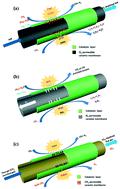当前位置:
X-MOL 学术
›
React. Chem. Eng.
›
论文详情
Our official English website, www.x-mol.net, welcomes your feedback! (Note: you will need to create a separate account there.)
Catalytic mixed conducting ceramic membrane reactors for methane conversion
Reaction Chemistry & Engineering ( IF 3.9 ) Pub Date : 2020-08-10 , DOI: 10.1039/d0re00177e Zhigang Wang 1, 2, 3 , Tianjia Chen 1, 2, 3 , Nikita Dewangan 1, 2, 3 , Ziwei Li 1, 2, 3 , Sonali Das 1, 2, 3 , Subhasis Pati 1, 2, 3 , Zhan Li 1, 2, 3 , Jerry Y. S. Lin 4, 5, 6, 7, 8 , Sibudjing Kawi 1, 2, 3
Reaction Chemistry & Engineering ( IF 3.9 ) Pub Date : 2020-08-10 , DOI: 10.1039/d0re00177e Zhigang Wang 1, 2, 3 , Tianjia Chen 1, 2, 3 , Nikita Dewangan 1, 2, 3 , Ziwei Li 1, 2, 3 , Sonali Das 1, 2, 3 , Subhasis Pati 1, 2, 3 , Zhan Li 1, 2, 3 , Jerry Y. S. Lin 4, 5, 6, 7, 8 , Sibudjing Kawi 1, 2, 3
Affiliation

|
The application of catalytic mixed conducting ceramic membrane reactors shows great promise for industrial processes to produce value-added chemicals. A catalytic membrane reactor combines separation and reaction in one unit and also synergistically enhances the membrane permeability and catalyst activity, resulting in process intensification. This article presents a review on the development of O2 permeable, H2 permeable and CO2 permeable catalytic mixed conducting ceramic membrane reactors for methane conversion. The majority of such studies focus on the application of O2 permeable ceramic membrane reactors while fewer applications of H2 permeable and CO2 permeable ceramic membrane reactors have been reported. These catalytic mixed conducting ceramic membrane reactors are mainly applied in several CH4 conversion reactions, such as partial oxidation of methane (POM), steam reforming of methane (SRM), dry reforming of methane (DRM), oxidative/nonoxidative coupling of methane (OCM/NCM), and methane aromatization (MA), and bifunctional membrane reactors. The performance, advantages and challenges of catalytic membrane reactors for various reactions are summarized and discussed. Finally, the prospects and direction of future development of mixed conducting membranes for industrial application are discussed and highlighted.
中文翻译:

用于甲烷转化的催化混合导电陶瓷膜反应器
催化混合传导陶瓷膜反应器的应用显示了工业过程生产增值化学品的巨大希望。催化膜反应器将分离和反应结合在一个单元中,并且还协同提高了膜的渗透性和催化剂活性,从而导致了工艺强度的提高。本文介绍了O 2可渗透,H 2可渗透和CO 2可渗透的催化混合导电陶瓷膜反应器用于甲烷转化的研究进展。大多数此类研究集中于O 2渗透性陶瓷膜反应器的应用,而H 2渗透性和CO 2的应用较少已经报道了可渗透的陶瓷膜反应器。这些催化混合传导陶瓷膜反应器主要应用于甲烷的部分CH 4转化反应(POM),甲烷的蒸汽重整(SRM),甲烷的干重整(DRM),甲烷的氧化/非氧化偶联( OCM / NCM),甲烷芳构化(MA)和双功能膜反应器。总结和讨论了催化膜反应器在各种反应中的性能,优点和挑战。最后,对工业用混合导电膜的发展前景和发展方向进行了讨论和重点介绍。
更新日期:2020-09-29
中文翻译:

用于甲烷转化的催化混合导电陶瓷膜反应器
催化混合传导陶瓷膜反应器的应用显示了工业过程生产增值化学品的巨大希望。催化膜反应器将分离和反应结合在一个单元中,并且还协同提高了膜的渗透性和催化剂活性,从而导致了工艺强度的提高。本文介绍了O 2可渗透,H 2可渗透和CO 2可渗透的催化混合导电陶瓷膜反应器用于甲烷转化的研究进展。大多数此类研究集中于O 2渗透性陶瓷膜反应器的应用,而H 2渗透性和CO 2的应用较少已经报道了可渗透的陶瓷膜反应器。这些催化混合传导陶瓷膜反应器主要应用于甲烷的部分CH 4转化反应(POM),甲烷的蒸汽重整(SRM),甲烷的干重整(DRM),甲烷的氧化/非氧化偶联( OCM / NCM),甲烷芳构化(MA)和双功能膜反应器。总结和讨论了催化膜反应器在各种反应中的性能,优点和挑战。最后,对工业用混合导电膜的发展前景和发展方向进行了讨论和重点介绍。



























 京公网安备 11010802027423号
京公网安备 11010802027423号